

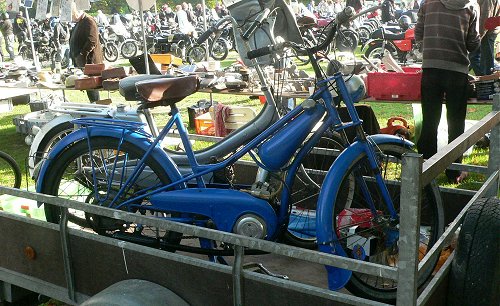
In the last issue, we showed you the VBF moped at this year's Sars Poteries Rando Cyclos ... You wait years to see a VBF, then two come along at once.
This one was in the jumble at NVT: Nationaal Veteraan Treffen. NVT is a huge one-day motor cycle rally held at Woerden in the Netherlands.
The VBF at Sars Poteries had a Le Poulain Cyclobloc engine, this one is a different model and has an ABG engine: a VAP model B. (The model B was covered in issue 15 of The MAC in our series about VAP engines.)
The frame is similar to the Le Poulain version, but modified to fit the different engine. For example, this frame has a bottom bracket, but on the Le Poulain, the pedals were incorporated in the engine. Other differences are not dictated by the engine type but point to it being a later model, or a more expensive model, or both. It has telescopic forks and the fuel tank has been moved from under the saddle to the front of the frame.
It probably dates from 1954 or 1955.
One question that we haven't answered is: what does VBF stand for?
VBF was originally a cycle manufacturer and "Votre Bicyclette Favori" is one suggestion. VBF certainly used this as a slogan - but it looks more like a phrase that has been fitted to the initials than their origin.
First published in The MAC in December 2011
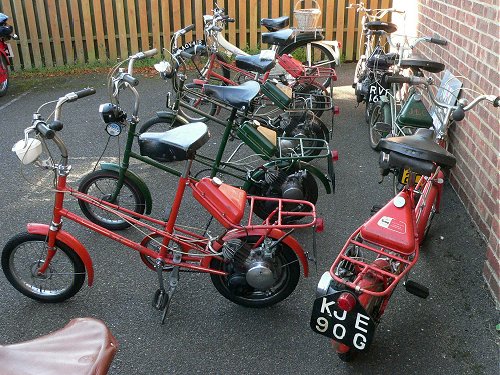
For this 'Spotted' we have, not one machine, but seven ... and they're all Clark Scamps!
There were eight Scamps at the Coprolite Run - plus two extra wheels and motors; number eight and the two wheels were on show inside the hall.
Four of the Scamps took part in the run and three of them made it all the way round. The fourth suffered a rear wheel puncture - which is not a simple roadside repair on a Scamp. Cyclemaster owners will appreciate the difficulty of changing a tube on a bike where the engine is part of the rear wheel. The Scamp is even more awkward and it's quicker to unbolt the engine from the wheel than to attempt to fix the puncture with the power unit in one piece.
Of course, it wasn't coincidence that so many Scamps turned up at a single event - well, not wholly. It was coincidence that a couple of Suffolk members happened to be restoring Scamps - and the idea grew from there.
Three of the Scamps - one of each colour - were reunited a fortnight later to go on display on the EACC stand at Copdock.
Two of the Scamps have since passed to new owners; it's unlikely that this many Scamps will be seen in the same place for many years.
First published in The MAC in December 2011
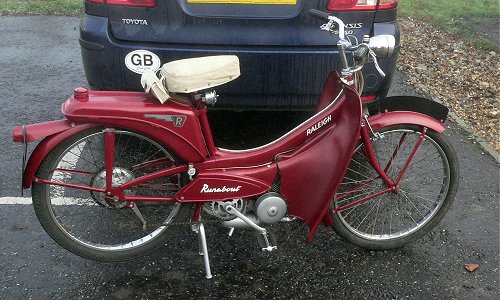
In these columns we tend to pick on the more unusual machines that make an appearance at our events. It's about time we had a look at some of the more popular machines. And what could be more popular than a Raleigh Runabout?
Raleigh introduced a range of mopeds based on the French Motobécane in 1961, following the merger of Raleigh with Tube Investments. Various models were made over the following ten years with a total production of around 190,000 machines.
The basic model in the Raleigh range was the Runabout or RM6. The Runabout was a single-speed, single-seater with no suspension and a simple cycle-type calliper brake on the front wheel. Although the Runabout was meant to be the most basic model of the range, there were several variants of the Runabout. The most austere of these was the Pop and the most luxurious was the Super de Luxe.
The machine in our picture - taken in a fog-shrouded car park at Kneel's Wheels last November - is one of these Super de Luxe models: the top of the Runabout 'sub-range'. The Super de Luxe was made from November 1965 until September 1969 and can be recognised by its legshields and all-over Royal Carmine colour scheme.
First published in The MAC in March 2012
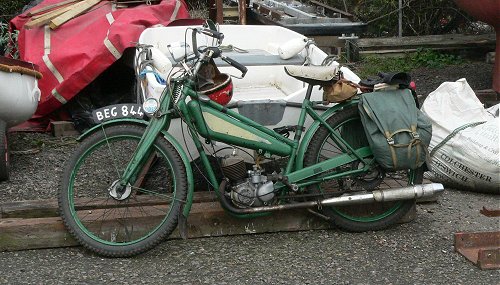
Continuing our theme of popular models brings us to the New Hudson autocycle. Not quite in the same league as the Raleigh, the total production of New Hudsons was in the region of 29,000. Like most autocycles, the New Hudson was changed in 1950 to accommodate the Villiers 2F engine instead of the Junior de Luxe. Unlike other autocycles, the New Hudson was further developed into a Re-styled version in 1956.
The New Hudson was more popular than other autocycles for one simple reason - it was cheaper.
All Villiers 2F powered autocycles are rather alike with a spring fork, rigid frame, 21-inch wheels and the same engine - so price becomes a significant factor in deciding which make to buy.
The New Hudson below, seen at this year's Mince Pie Run is the 'middle' model that accounted for about half of New Hudson's total production.
This particular machine is a familiar sight at club events. Keith Ashby not only rides it at events but also uses it to get to the event and to go home afterwards. This bike will be 60 years old this year and it's still going strong transporting its owner over considerable distances.
First published in The MAC in March 2012
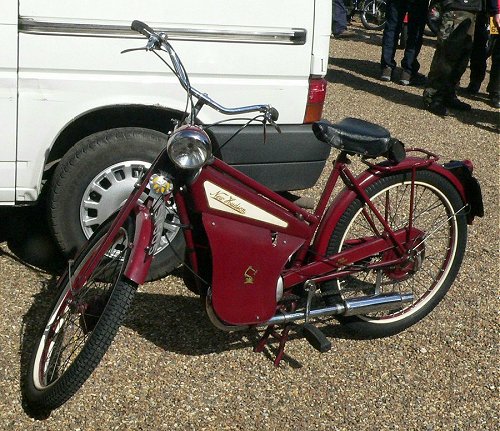
This short-lived model of the New Hudson was announced in November 1955 and is a sort of interim version preceding the introduction of the Re-styled model five months later. Legshields and a windscreen were offered as optional extras on this model; no doubt these were also items that had been developed ready for the launch of the Re-styled model.
That description might seem familiar - we've already featured a 'transitional' New Hudson in these columns back in 2010 when Dave Watson brought his unrestored example to Horham. We also presented Keith Ashby's New Hudson in the last issue of this newsletter.
So why another New Hudson in these pages?
It's because this is the one that used to belong to Michael Flood. It used to be regularly seen on club runs and many of those present at the Radar Run were very pleased to see it back in circulation.
At the time of the run, its new owner was hoping that he'd be able to use it regularly on our events. However, things don't always turn out as planned and he later found that would not be the case. Nevertheless, the New Hudson will continue to be seen on our runs - rather than 'mothball' it, the bike has been moved on to a new owner.
First published in The MAC in June 2012
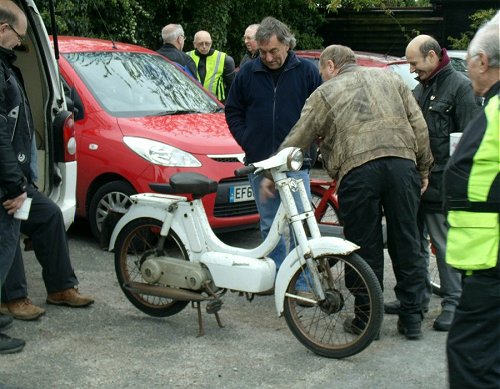
Centre of attention at the East Anglian Run was this moped. The sweep of the frame, the transmission, the enclosed fan-cooled engine and the headlamp and handlebar enclosure all make it look as if it was designed by someone more used to building scooters. And with good reason, because this is a Vespa Vespino.
The Vespino (called the Vespino Tourist in other countries) was first imported to the UK in July 1968. The following year, it was renamed to Vespino Auto Super when a dual-seat version - the Vespino Auto Luxe - was added to the range. The Luxe was a short-lived version, only imported from June 1969 to April 1970. The single-seat Super carried on until October 1971.
That wasn't quite the end for the Vespino in the UK as, after a gap of a year, the Vespino Tourist Rally made its debut here.
The Vespino at the East Anglian Run is another machine from the Dave Watson Collection and is a genuine UK version dating from 1970. A recent acquisition, Dave had brought it along for its V765 inspection so it didn't take part in the run - appropriately, Dave rode one of its cousins: a Ciao.
First published in The MAC in June 2012
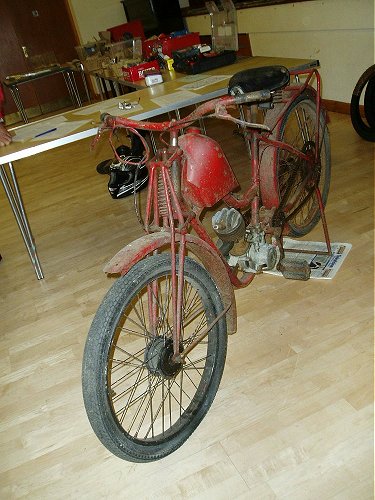
We're going back to 2006 for this "Spotted", but there is a reason that makes it more topical. It was even longer ago (20 years or more) when this French autocycle first appeared at a club event. Since then it has changed hands at least five times and, in all that time, no one has been able to positively identify it.
Until recently, that is.
The French motor cycle newspaper La Vie de la Moto has been printing a long-running series of articles on all the motor cycles built in the Seine area of France and, on 28 June this year, published the information we needed to put a name to this machine.
It was built by Georges Roès at 152 boulevarde de la Gare in Paris's 13th arrondissement. It could have been badged as either a "G Roès" or "Le Petit Roi".
A unique feature to Georges Roès's machines was the clutch, patented by him in 1932. The clutch is normally disengaged and the engine drives the rear wheel through a freewheel; the bike will coast freely when the throttle is closed. Pulling the handlebar lever engages the clutch to override the freewheel and is used when starting or to use engine braking. This model, with its step-through frame, was for women or priests - a man's version was also produced.
Out featured machine has the patent clutch and probably dates from around 1935.
LVM was not aware of any surviving examples of Le Petit Roi in France - maybe this is the only one left.
First published in The MAC in September 2012
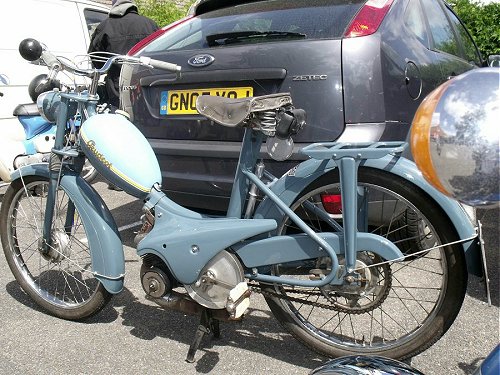
We stay in France for our second featured machine. This is Jim Stuttard's Peugeot, pictured at July's Peninsularis Run. Peugeot's first mopeds were roller drive: the VAP-powered BMA25 and then the Bima, with their own engine.
Peugeot's first 'proper mopeds' were launched at the 1957 Paris Salon. The BB range of Peugeots worked on similar lines to the Mobylette with an automatic clutch, belt primary drive and chain final drive. The first models were unusual in having a powder clutch (an idea that Raleigh was also considering for a successor to the RM2).
The BB became the BB1 as Peugout's moped range expanded into 2-speed (BB2), 3-speed (BB3) and Variomatic (BBV) models.
There were also variations within the BB1 range depending on what equipment was fitted. Jim's is a BB1T and the "T" indicates that it is a fitted with a telescopic fork.
Dating from 1962, Jim's Peugeot has the more conventional centrifugal clutch that superseded the powder version. It is a French model, though they were also imported into the UK in the 1950s and 1960s.
Put back on the road earlier this year, this Peugeot has been at a number of events, most recently the Periwinkle Run on 19 August.
First published in The MAC in September 2012